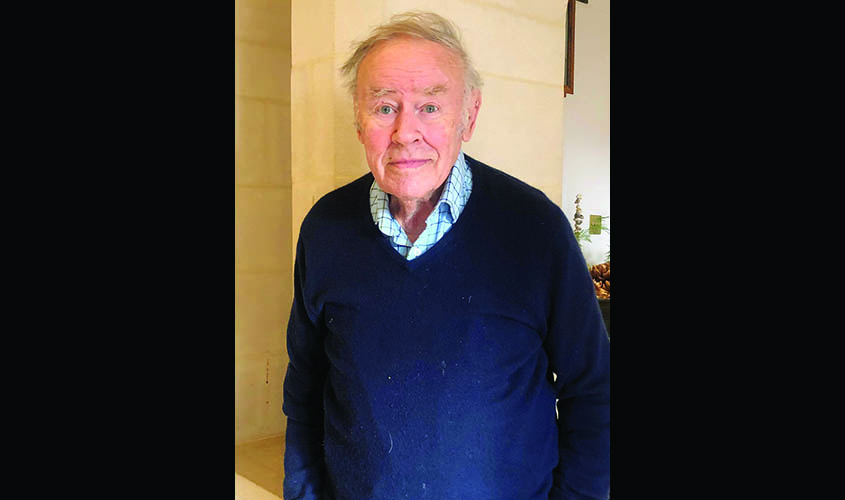Michael Bertioli has been described as one of the greatest engineering brains of the 20th century. This reporter recently had the privilege of a chat with the sprightly 86 year old. In the early 1960’s Bertioli invented the modern transducer, something that in one form or another is now used daily in the medical, aeronautical, agricultural and engineering industries.
As a boy, Bertioli was intrigued by how things worked; he was always making machines out of Meccano, the model construction system for mechanical devices. At Grammar School he excelled in physics and chemistry, remembering the charismatic character of his physics teacher who was approachable and encouraged dialogue, and his mathematics teacher who was similarly engaging and inspiring. The young Bertioli had discovered the link between mathematics, engineering and physics, which led him to hi-jack the electricity supply to his parents’ garage for ten years in order to power his welder. Bertioli tried for Birmingham University but priority was given to ex-service people after the war, and so he settled on a General Science and Special Physics degree at the London University Technical College in Birmingham. During this time, he worked at the Dunlop Research Centre, his first real experience of scientific problem solving. Then followed two years of National Service based at the Royal Airforce Technical College in Saffron Walden; it was here that he learned the fundamentals of radar, wave guides and aerials, and the management of people from a military perspective.
In 1957 he married Patricia Thacker. Their two sets of parents combined to buy the newlyweds a house which Bertioli promptly rebuilt, rewired and replumbed himself, he also included a small laboratory in his wife’s laundry room. Bertioli was then employed by Tube Investments (a manufacturer of stainless steel tubes and seals),this was his first experience of scientific research. Serendipity intervened: the head of his department was the son of Alfred North Whitehead who with Bertrand Russell had published the Principa Mathematica (three volumes on the foundations of mathematics). Whitehead encouragedBertioli to use his intellectual skills in mathematics to solve engineering problems.
In 1959 his friend David Millington persuaded Bertioli to join him at the Lucas Group Research Centre. Here their work was focussed on silicon semi-conductors and the silicon high voltage transistor. Bertioli’s understanding of the theory behind all the components alongside his practical ability qualified him to lead Lucas’ new physics department. Millington and Bertioli studied semi-conductors and how to make measurements on pieces of silicon. Using piezoresistance,they discovered that they could make different sorts of sensors for the measurementof force, pressure and acceleration. Their first success was a pressure transducer. Not long after Lucas had a stand at a physics exhibition, Bertioli was asked if he could measure blood pressure, thus the blood transducer was invented. John Salmon then joined Lucas as an electrical expert. Salmon had a knack for recognising a good idea, was skilled in communications and marketing—and was very well connected. He approached the Shield and Epstein Laboratories for a licence to produce the blood transducer. S&E with EMI then set up a manufacturing facility in London. Meanwhile Salmon had realised that there was a major market for Bertioli’s transducers—and other associated instrumentation.
Salmon had done some preparatory work with Scanivalve in the US who made suites of instruments for Boeing, and secured the interest of Scanivalve’s President and Founder John Pemberton. Salmon brought Pemberton to Bertioli’s laundry laboratory, he was impressed with the homemade workshop and exclaimed “this is magic!”. Bertioli and Salmon offered to make Pemberton a special sensor to measure the pressure of air in a wind tunnel that would fit into the Scanivalve, thus making aircraft more aerodynamic. This modified blood transducer had the advantages of speed and accuracy; previously measurements had been taken through a manometer, a simple U-tube with mercury. The new transducer allowed 64 tubesto be inserted into the Scanivalve that then reported to an early computer.
The principal device in the transducer is a diaphragm, a single piece of silicon cut from a silicon wafer. Bertioli’s idea was to put up to a hundred sensors on the wafer depending on its size. The pressure then bends the silicon into a shape, the strain gauges measure the value of the strain, the device is mounted onto something firm which then is wired to computerisation.Today a silicon wafer will still have up to a hundred sensors.
Salmon persuaded Bertioli to set up a manufacturing plant of their own in Leicestershire which they named Druck, the German word for pressure—and German because of their reputation for efficiency. They invested their own money while friendly engineers supplied “bits”. The first transducers were manufactured at Lucas before Druck took over and flourished. Druck was awarded the Queen’s Award for Industry and Bertioli himself an OBE for services to pressure measurement.Bertioli continued to invent and improve all manner of electrical devices until he retired at the age of 70. Druck was sold to US giant General Electric in 2009 andstill continues to make innovative and valuable pressure instrumentation to this day.

